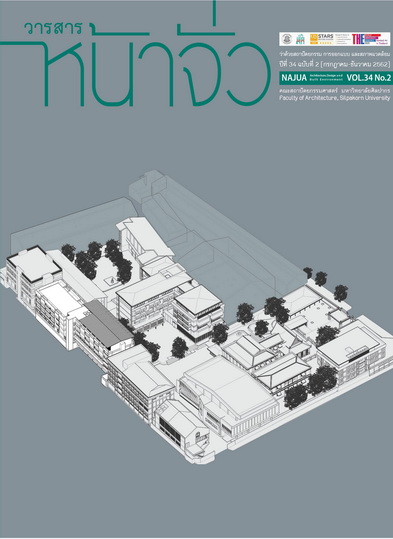Mixed-Use Study & Design for Public Area Usageon Footpath: Case Studies in Chiang Mai Old City, Thailand
Keywords:
Public Space, Mixed-use design, Footpath, Urban design, Creative cityAbstract
Chiranthanin Kitika
Faculty of Architecture, Chiangmai University
This article posits to study on public area usage and footpaths. Researcher chooses Phrapokkloa – Chang Phuak rd. as area of study where belongs to North-south axis of the old city. From 10 case studies, research methodology is referred to Neighborhood network which is a conceptual study to understand social space with conditions of physical design and social relations.
By location based learning, these public area usages appeared conflicts between old communities and business-purpose activities through existing government urban management. Mixed-use design is the design integration on urban development which provides flexibility program and manages diversity usage towards becoming Walkable city and Slow-Life city. Mixed-use design feature is to converge physical design with fostering social on specific location. This research is set to reclaim the new understanding of public area design with the concept of Mixed-use design. Furthermore, research finding is to analyze mixed-use design as new feature on public areas in Chiang Mai. These features aim to compromise conflicts and also improve functional programming on Chiang Mai public area.
References
- Department of Public Works and Town & Country Planning. (2006). Thailand Urban Planning Criterion & Standards: 2006. Bangkok, Thailand: Department of Public Works and Town & Country Planning.
- Grant, J. (2002). “Mixed Use in Theory and Practice”. in United States: APA Journal 68, no. 1: 71-84.
- Harris, C. W. & Dines N. T. (1998). Time-Saver Standards for Landscape Architecture. New York: McGraw-Hill Education – Europe.
Kitika, C. & Katsuhiko, S. (2016) “Integrated Neighborhood Network on A Case Study of Condominium Community: Nimmanhaemin area, Chiang Mai Thailand” in International Review for Spatial Planning and Sustainable Development Journal (IRSPSD) Vol. 4 (2016) No.1. J-STAGE & Press (SPSD). pp. 106-122.
- Lefebvre, Henri., D. Nicholson-Smitch, Trans. (1991). The production of space. MA: Blackwell.
- Lieorungruang, V. (2008). Lanna Architectural Conservation: Guidelines for Historic Buildings in Northern Thailand. Bangkok: Graduate School, Silpakorn University.
- Oranratmanee, R. (2012). The use of public space for walking street in a form of flea market in Thai urban cities. BKK: TRF.
- National Statistical Office. (2016). Provincial Statistic Report 2016. Retrieved July 31, 2018, from http://chiangmai.old.nso.go.th.
- Sookprecha, T. (2018). Urban Design - What is Elements for Good City. Retrieved July 31, 2018, from www.the101.world/urban-design.
- Suwatcharapinun, S. (2016). Chiang mai-mai: Modern architecture of Chiang Mai between 1884-1975. Chiang Mai: Chiang Mai University Publishing.
- Suwankantha, A. (2013). Northern Border Economic Zone. Retrieved 6 August 2016.
- Tansuklanun, P. & Phetcharanond, M. (2007). A search for vital public space: the Urban life of Khon Kaen. Khon Kaen: Faculty of Architecture, Khon Kaen University.




